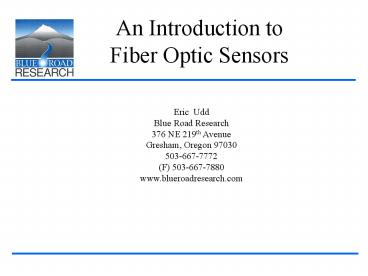An Introduction to Fiber Optic Sensors - PowerPoint PPT Presentation
1 / 68
Title:
An Introduction to Fiber Optic Sensors
Description:
Session 1 - Fundamental Components and Concepts ... Evanescence Based Sensors. Blue Road Research. Session 2, Page 9. Light. outputs. Light in ... – PowerPoint PPT presentation
Number of Views:8035
Avg rating:3.0/5.0
Title: An Introduction to Fiber Optic Sensors
1
An Introduction to Fiber Optic Sensors
Eric Udd Blue Road Research 376 NE 219th
Avenue Gresham, Oregon 97030 503-667-7772 (F)
503-667-7880 www.blueroadresearch.com
2
Outline
- Session 1 - Fundamental Components and Concepts
- Session 2 - Intensity Based and Fabry-Perot
Interferometric Sensors - Session 3 - Applications of the Fiber Optic
Sagnac Interferometer - Session 4 - The Mach-Zehnder and Michelson
Interferometers and Multiplexing - Session 5 - Fiber Optic Smart Structures for
Natural, Civil, and Aerospace Applications - Session 6 - Fiber Optic Grating Sensors and
Applications
3
Fundamental Components and Concepts
Blue Road Research
4
Fundamental Components and Concepts
- Sensor capabilities
- Advantages
- Historical trends
- Sensor types
- Fundamental components
- Fiber fabrication / coupling
- Light sources
- Modulators
- Detectors
5
Fiber Optic Sensor Capabilities
- Rotation, acceleration
- Electric and magnetic fields
- Temperature and pressure
- Acoustics and vibration
- Strain, humidity, and viscosity
6
Fiber Optic Sensor Advantages
- Lightweight / nonobtrusive
- Passive / low power
- EMI resistant
- High sensitivity and bandwidth
- Environmental ruggedness
- Complementary to telecom / optoelectronics
7
Fiber Optic Sensors Historical Trends
Few, high-priced components, laser diodes,
microoptics
Low-cost basic components, laser diodes
pigtailed, fiber beamsplitters
Low-cost complex components, mass produced
integrated optics
8
Fiber Optic Sensors Historical Trends
Niche markets - RF temperature
Mass markets emerge - fiber gyros, medical, lab
instruments, manufacturing
Fiber optic systems - fiber optic smart
structures, industrial systems
9
Fiber Optic Sensors Whats Next?
Fiber optic health and structural monitoring
systems on about 100 bridges, aerospace SHM
technology moves toward level 6
Hundreds of civil structure installations,
aerospace fiber optic SHM moves to level 8 and 9
with initial deployments
Fiber optic SHM systems are mandated on new civil
and aerospace structures
10
Fiber Optic Sensors Whats Next?
Oil and gas deployments start to appear
Hundreds of oil and gas wells uses downhole fiber
optic sensor systems, platforms begin to use
fiber optic SHM systems
Thousands of systems are deployed for many high
value oil and gas wells, fiber optic SHM mandated
on some oil platforms
11
Extrinsic Fiber Optic Sensors
12
Intrinsic Fiber Optic Sensors
13
Fundamental Components
- Optical fiber
- Light sources
- Beam conditioning optics
- Modulators
- Detectors
14
Total Internal Reflection
15
Optical Fiber Structure
16
Types of Optical Fiber
- Multimode step index
- Graded index multimode
- Single mode
- Polarization preserving
- Polarizing
17
Types of Polarization Preserving Fiber
Elliptical clad
Soft glass side pit
Stress rod
18
Fiber Depolarizer
19
Fiber Fabrication Types
- Modified chemical vapor deposition
- Outside chemical vapor deposition
- Vapor axial deposition
- Rods in glass tube
20
Fiber Coupling Techniques
- Fused biconical taper
- Polished
- Etched
- Microoptic
- Integrated optic
21
Fiber Coupling Techniques
22
Light Sources
- Light emitting diodes
- Laser diodes
- Superradiant diodes
- Fiber Lasers
23
Spontaneous Emission
- Low probability of photon interaction
- Wide spectral bandwidth
- High immunity to low level backscatter
24
Stimulated Emission
- High probability of photon interaction
- Narrow bandwidth due to spectral selectivity of
cavity - High sensitivity to low level backscatter
25
Superradiance
- High probability of photon interaction
- Wide bandwidth due to spectrally nonselective
cavity - Moderate sensitivity to backscatter
26
Surface Emitting LED
27
Laser Diode and Edge Emitting LED Structures
28
Characteristic Current/Power Curves
29
Fiber Lasers
30
Fiber Optic Modulators
- Electrooptical
- Acoustooptical
- Magnetooptical
- Mechanical
31
Electrooptic Modulator
32
Acoustooptic Modulator
33
Mechanical Modulators
Constriction
34
Detectors
- PIN photodiodes
- Avalanche photodiodes
- Spectrally selective detectors
35
Summary - Basic Elements of a Fiber Optic Sensor
36
Intensity Based and Fabry-Perot Interferometric
Sensors
Blue Road Research
37
Closure and Vibration Sensors Based on Numerical
Aperture
38
Closure and Vibration Sensors Based on Numerical
Aperture
39
Translation Sensor Based on Numerical Aperture
40
Rotary Position Based on Reflectance
41
Linear Position Sensors Wavelength Division
42
Linear Position SensorsTime Division
43
Critical Angle Pressure/Index of Refraction
Measurement
44
Liquid Level Sensor Based on Total Internal
Reflection
45
Evanescence Based Sensors
46
Microbend Fiber Sensors
47
Grating Based Intensity Sensor
48
Dynamic Range Limit
49
Dual Grating Mask, 90 Degrees Out of Phase
50
Quadrature Detection
51
Limitations of Intensity Based Fiber Optic Sensors
- Variable loss due to connectors
- Microbending losses
- Macrobending losses
- Mechanical losses due to creep and misalignment
52
Spectral Approaches
- Self referenced intensity sensors based on dual
wavelengths - Fiber optic sensors based on spectral response
- Blackbody radiation
- Absorption/fluorescence
- Dispersive elements - gratings and etalons
53
Blackbody Sensors
54
Blackbody Radiation
55
Variable Absorption Probes
56
Fluorescent Probes
57
Absorption/Fluorescent Systems
58
Fiber Grating
59
Fiber Grating System
60
Grating Based Position Sensor
61
Hybrid Etalon Based Fiber Sensors
62
Etalon Finesse
63
Demodulators for Broadband Etalons
64
Fiber Etalons
65
Fly by Light System
66
Fly by Light System-Airframe
67
Fly by Light System-Engine
68
Summary - Intensity and Spectrally Based Fiber
Sensors
- Intensity based sensors
- Offer simplicity and low cost
- Are subject to variable attenuation errors
- Spectral techniques may be used to minimize
attenuation errors































